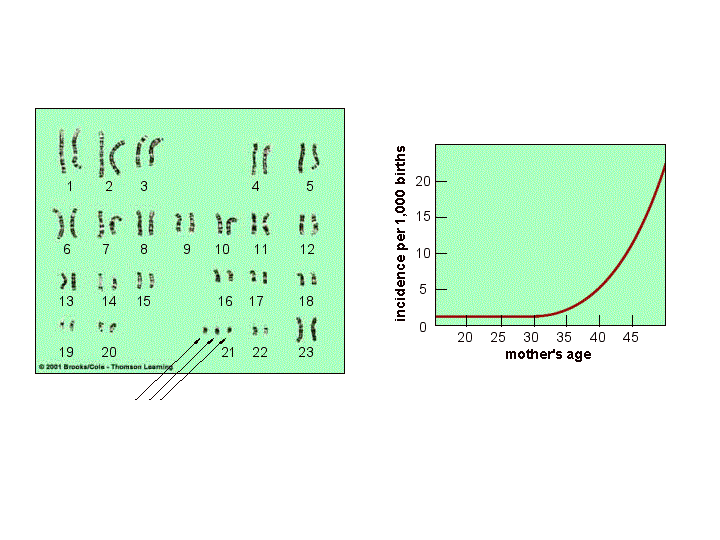

Polyploidy is three or more of each chromosome. It is common in flowering plants but is lethal to the zygote if it occurs in humans.
Nondisjunction at anaphase I or anaphase II frequently results in a change in chromosome number.
If a gamete with an extra chromosome (n + 1) joins a normal gamete at fertilization, the diploid cell will be 2n + 1. This condition is called trisomy.
If an abnormal gamete is missing a chromosome, the zygote will be 2n - 1. This condition is called monosomy.
Changes in the Number of Autosomes
Down syndrome results from trisomy of chromosome 21 . 1 in 1,100 live newborns in North America are affected. Most children with Down syndrome show mental retardation, and 40% have heart defects. Down syndrome occurs more frequently in children born to older women.
Changes in the Number of Sex Chromosomes
Klinefelter syndrome caused by nondisjunction (mostly in the mother) results in an extra X chromosome in the cells (XXY) of affected males. These individuals are taller than average, usually are sterile, and may show some mental slowness, and feminized traits. It can be treated with testosterone injections.
XYY condition results from an extra Y chromosome in males. It does not affect fertility, but affected individuals are taller than average and are slightly mentally retarded. Erroneous correlations have linked these persons with predisposition to crime.
Phenotypic Treatments
Symptoms of many genetic disorders can be minimized or suppressed by dietary controls, adjustments to environmental conditions, surgery, or hormonal treatments.
Genetic Screening
Large-scale screening programs can detect affected persons. For example, newborns in United States are routinely tested for phenylketonuria or PKU, a disease which results from the lack of a particular enzyme. Early detection allows dietary intervention and prevents brain impairment.
Prenatal Diagnosis
Techniques such as amniocentesis can be used to detect potential risks, such as Down syndrome prior to birth.
REVIEW: Nondisjuction can be caused by _____ .��
REVIEW: �A gamete affected by nondisjuction would have _____ .
a. a change from the normal chromosome number
b. one extra or one missing chromosome
c. the potential for a genetic disorder
d. all of the above�
REVIEW: Amniocentesis involves sampling��
REVIEW: The condition occurring when an organism has a 2n + 1 chromosome composition is known as��
REVIEW: In Down syndrome��
REVIEW: The sex chromosome composition of a person with Turner syndrome is��
PREVIOUS
NEXT
LECTURE 16 INDEX
MAIN INDEX